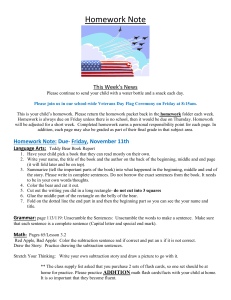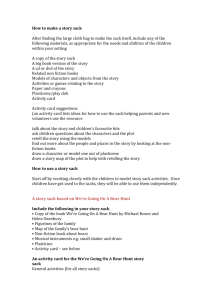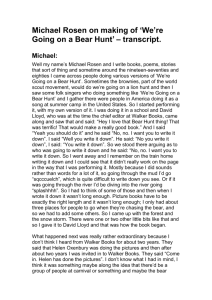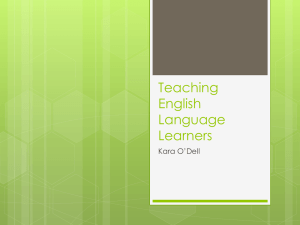R - BGfL - Birmingham Grid for Learning
advertisement
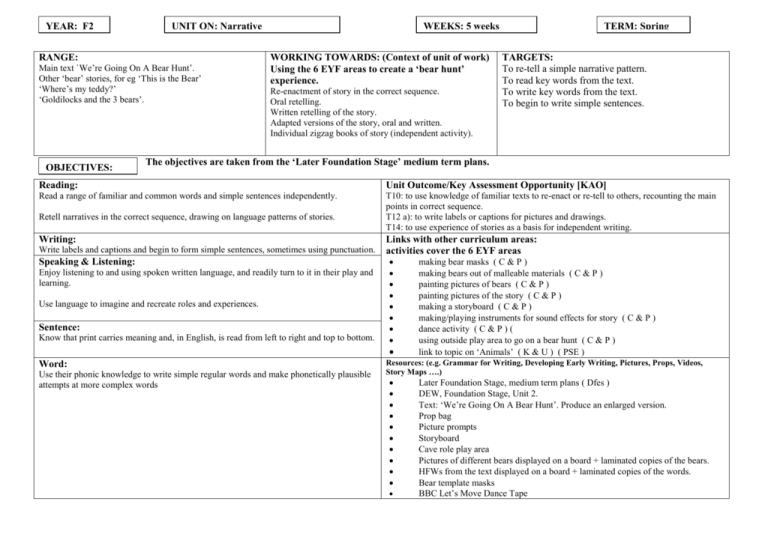
RYEAR: F2 UNIT ON: Narrative RANGE: Main text `We’re Going On A Bear Hunt’. Other ‘bear’ stories, for eg ‘This is the Bear’ ‘Where’s my teddy?’ ‘Goldilocks and the 3 bears’. OBJECTIVES: WEEKS: 5 weeks WORKING TOWARDS: (Context of unit of work) Using the 6 EYF areas to create a ‘bear hunt’ experience. Re-enactment of story in the correct sequence. Oral retelling. Written retelling of the story. Adapted versions of the story, oral and written. Individual zigzag books of story (independent activity). TERM: Spring TARGETS: To re-tell a simple narrative pattern. To read key words from the text. To write key words from the text. To begin to write simple sentences. The objectives are taken from the ‘Later Foundation Stage’ medium term plans. Reading: Unit Outcome/Key Assessment Opportunity [KAO] Read a range of familiar and common words and simple sentences independently. T10: to use knowledge of familiar texts to re-enact or re-tell to others, recounting the main points in correct sequence. T12 a): to write labels or captions for pictures and drawings. T14: to use experience of stories as a basis for independent writing. Retell narratives in the correct sequence, drawing on language patterns of stories. Writing: Write labels and captions and begin to form simple sentences, sometimes using punctuation. Speaking & Listening: Enjoy listening to and using spoken written language, and readily turn to it in their play and learning. Use language to imagine and recreate roles and experiences. Sentence: Know that print carries meaning and, in English, is read from left to right and top to bottom. Links with other curriculum areas: activities cover the 6 EYF areas Word: Use their phonic knowledge to write simple regular words and make phonetically plausible attempts at more complex words making bear masks ( C & P ) making bears out of malleable materials ( C & P ) painting pictures of bears ( C & P ) painting pictures of the story ( C & P ) making a storyboard ( C & P ) making/playing instruments for sound effects for story ( C & P ) dance activity ( C & P ) ( using outside play area to go on a bear hunt ( C & P ) link to topic on ‘Animals’ ( K & U ) ( PSE ) Resources: (e.g. Grammar for Writing, Developing Early Writing, Pictures, Props, Videos, Story Maps ….) Later Foundation Stage, medium term plans ( Dfes ) DEW, Foundation Stage, Unit 2. Text: ‘We’re Going On A Bear Hunt’. Produce an enlarged version. Prop bag Picture prompts Storyboard Cave role play area Pictures of different bears displayed on a board + laminated copies of the bears. HFWs from the text displayed on a board + laminated copies of the words. Bear template masks BBC Let’s Move Dance Tape Week 1: Elements of the week’s work can be covered at any time during the day. Teaching sequence – shared time Objectives Teaching and Learning Activities – group work familiarisation, capturing ideas, demonstrating, teacher scribing, independent writing T7: to use knowledge of familiar texts to re-enact or retell to others, recounting the main points in sequence. Whole class: familiarisation is the main focus but all other aspects of the teaching sequence are included. Ask children to go hunting in the ‘prop bag’ for story picture prompts. Ask children to talk to each other about the pictures, support them by asking appropriate questions, ‘What can you see?’, ‘Who can you see?’, ‘What is this story about?’ etc. Display the pictures to prompt discussion (the sequence isn’t important at this stage). Read the story. Share reading the text and support with story actions. Emphasise the repetitive phrases and sound effects and practise them with the children. Plenary Activities/ Learning Outcomes Group work. Class Teacher focus: (Guided work) Sequence the story prompt pictures. Children to draw pictures of the physical features and write a list of key words, (i.e. grass, mud ). Differentiate appropriately for each group and provide resources for children to attempt independent writing, for eg. alphabet cards. Plenary: Use the text to identify HFWs and focus on dominant phonemes in key words. Listen to a group retelling the story. Group work. Teaching Assistant focus: (Guided work) Using numbered story prompt pictures retell the story. Practise the words and phrases. (Use this activity for a plenary). Physical Development: Let’s Move Dance Tape. Other adult support if available: talk about bears, think of words to describe how they look and move. Explore how they move. Using who, what, where, when, why, ask questions about the text. Over the week follow DEW p37/38, Session 1, Talk for Writing and Shared Writing. Listen to the Let’s Move tape. Story time: involve the children in a dramatised retelling of the story using story prompts and puppets/masks. Keep practising the text with the story actions. Supporting/independent activities: (there were a selection of other activities but these specifically supported the text) Hunt for key words from the text around the room. Make bear masks. Use ‘Bear Hunt’ picture and word cards, draw the pictures and copy the words on whiteboards. Hunt for objects in the sand and make a list on the chalkboard of what has been found. ICT: Clicker, using a grid to write ‘bear’ story sentences. Chalk walls: draw pictures of the bear in the cave. Plasticine: make pictures of the bear in the cave. Paint pictures of the story. Evaluation: The children really enjoyed the story and were beginning to remember some key words and phrases. The story actions really supported their enjoyment and involvement in the text. A great deal of input was needed to support the children in remembering and using the story language. There needed to be greater emphasis on supporting the language through role-play and story telling. Children still used individual words rather than the story sentences. Week 2: Elements of the week’s work can be covered at any time during the day. Objectives Teaching sequence – shared time familiarisation, capturing ideas, demonstrating, teacher scribing, independent writing T10: To remember key words and phrases and use them in oral retellings of the story. T12 a): To write key words/sentences based on a familiar text. Whole class: familiarisation, demonstrating, teacher scribing Ensure that the storyboard/map is ready. Share reading the story. Retell the story with actions. Go ‘hunting’ in the prop bag for story picture prompts and display them. Ask children to talk to each other about the sequence of events, display the pictures in the correct order. Children to retell the story using the picture prompts, keep emphasising the patterned language. ‘ Teacher to demonstrate writing sentences (titles) for the physical features of the story, i.e ‘long wavy grass’ and position on story map. Share writing sentences for the story map. Children to copy or independently write the story sentences and position on the story map. Refer to DEW Listen to the Let’s Move tape. (unit of dance work planned for PD session) Teaching and Learning Activities – group work Ensure that the ‘cave’ is ready. Plenary Activities/ Learning Outcomes Group work: Class Teacher focus, (Guided Work) Prepare children’s books with the title ‘On my journey I went through…..’. Sequence the story prompt pictures. Children to draw a picture of a bear in the cave and then to write sentences for the physical features. Differentiate ‘writing activity’ appropriately for each for ability group. Provide appropriate resources to encourage independence. Identify HFWs from the text. Group work: Teaching Assistant focus, (Guided work). Use the storyboard to retell the story and to develop S & L. Use the storyboard to retell the story. Other adult support if available: Use the F2 playground to take children on a ‘bear hunt’. ICT work using Clicker. Supporting/independent activities: (there were a selection of other activities but these specifically supported the text) Hunt for key words from the text around the room. Make bear masks. Use ‘Bear Hunt’ picture and word cards, draw the pictures and copy the words on whiteboards. Hunt for objects in the sand and make a list on the chalkboard of what has been found. ICT: Clicker, using a grid to write ‘bear’ story sentences. Practise reading text. Use ‘cave’ role play area. Evaluation: The emphasis on S & L for the EAL children with the greatest needs cannot be under-estimated. Identify initial, final and dominant phonemes in key words. Listen to individuals/groups retelling the story using the story map. Physical Development: Separate timetabled session. Let’s Move Dance Tape. Story time: Involve the children in a dramatised retelling of the story using the story map and puppets/masks/small world people. Week 3 & 4: Elements of the week’s work can be covered at any time during the day. Teaching sequence – shared time Objectives Teaching and Learning Activities – group work Plenary Activities/ Learning Outcomes Week 3: Group work: Class Teacher focus, (Guided Work) Children to write ‘new’ versions of the story by changing the character. Involve children in a dramatised retelling of the changed story using the story map/picture prompts and small world people. familiarisation, capturing ideas, demonstrating, teacher scribing, independent writing T10: To remember key words and phrases and use them in oral retellings of the story. T12 a): To write key words / sentences based on a familiar text. Week 3: Whole class: Capturing ideas. Talk to the children about how the story can be adapted by changing the characters. Class Teacher to adapt the story by changing the ‘bear’ for another animal. Children to discuss with a partner which animal they would like the story to be about. Share writing a list of ‘animals’. (Teacher scribing) Using the story map retell the story with different animals. (Using the lists of animals produce sets of story picture prompts for oral retellings of the ‘new’ story.) Week 4: Group work: Teaching Assistant focus, (Guided work). Use the storyboard to retell the story using a new character. Link to phonic work. Supporting/independent activities: As for previous weeks. Children to make their own zig-zag books of story. Hunt for bear pictures around the classroom. Whole class: Capturing ideas. Talk to the children about how the story can be adapted by changing the settings/physical features. Class Teacher to adapt the story by changing the physical features. Children to talk with a partner about different settings that could be included in the story. Share writing a list of settings. (Teacher scribing) Using the story map retell the story with different ‘settings’. (Using the lists of settings produce sets of story picture prompts for oral retellings of the ‘new’ story.) Use the Let’s Move tape. Week 4: Group work: Class Teacher focus, (Guided Work) Children to write ‘new’ versions of the story by changing the setting. Group work: Teaching Assistant focus, (Guided work). Use the storyboard to retell the story using the new settings. Link to phonic work. Supporting/independent activities: As for previous weeks. ICT: children to use Powerpoint version of new/changed story. Children to use new version of story ‘We’re Going On a Cow Hunt’ created by Macromedia Flash. Evaluation Through continued reinforcement and practise all the children are having greater success in remembering words or sentences from the story, or can retell a new version of the stoty. Key Assessment Opportunity: comments Refer to the Learning Objectives. Week 5 Objectives Teaching sequence – shared time Teaching and Learning Activities – group work familiarisation, capturing ideas, demonstrating, teacher scribing, independent writing T14: to use Whole class : independent writing. Supporting/independent activities: As for previous weeks. experience of Children to make their own zig-zag books of story. stories as a basis Key Assessment Opportunity All children to ‘write’ their own version of ‘We’re Going On A Bear Hunt for bear pictures around the classroom. for independent Hunt’ writing, e.g.reICT: children to use Powerpoint version of telling and new/changed story. substitution Use the Let’s Move Tape. Children to use new version of story ‘We’re Going On through shared a Cow Hunt’ created by Macromedia Flash. composition with adults. Evaluation: The difference in the written outcome for the ability groups was considerable. The most able children could write their own story sentences for a new story, while the lower achievers drew a picture and copied their own story sentence or attempted to write key words. Key Assessment Opportunity: comments Refer to the Learning Objective. Plenary Activities/ Learning Outcomes Ask children to read or re-tell their new story versions.

